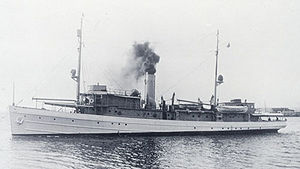USC&GS Guide (1918)
 USC&GS Guide | |
| Career (United States) | 100x35px |
|---|---|
| Name: | Guide |
| Namesake: | Guide, a person who leads anyone through unknown or unmapped country |
| Builder: | New Jersey Drydock and Transportation Company, Elizabethport, New Jersey |
| Laid down: | 18 October 1917 |
| Launched: | 24 August 1918 |
| Completed: | February 1919 |
| Acquired: | 23 January 1923 by U.S. Department of Commerce via transfer from U.S. Navy |
| Homeport: | San Diego, California |
| Nickname: | Guide and survey ships USC&GS Discoverer and USC&GS Pioneer collectively were known as the "Bird Boats" |
| Fate: | Transferred to U.S. Navy 27 June 1941 |
| Notes: |
Served as United States Navy minesweeper USS Flamingo (AM-32) 1919-1922 Served as U.S. Navy rescue and salvage ship USS Viking (ARS-1) 1942-1953 Sold for scrapping 1953 |
| General characteristics | |
| Type: | Survey ship |
| Displacement: | 850 to 950 tons |
| Length: | 187.8 ft (57.2 m) |
| Beam: | 35.5 ft (10.8 m) |
| Draft: | 9.8 ft (3.0 m) |
| Installed power: | 1,200 shaft horsepower (1.6 megawatts) |
| Propulsion: | Two 200-psi Babcock and Wilcox boilers; Harlan and Hollingsworth Corporation vertical triple expansion engine; one shaft |
| Speed: | 14 knots |
The first USC&GS Guide was a survey ship that served in the United States Coast and Geodetic Survey from 1923 to 1941.
Contents
Guide was laid down as the United States Navy minesweeper USS Flamingo (Minesweeper No. 32) by the New Jersey Drydock and Transportation Company at Elizabethport, New Jersey, on 18 October 1918. She was launched on 24 August 1918 and commissioned on 12 February 1919.
Flamingo assisted in sweeping the North Sea Mine Barrage in 1919. She was placed in ordinary in November 1920 and decommissioned in May 1922.
United States Coast and Geodetic Survey career
The Navy transferred Flamingo to the Coast and Geodetic Survey for use as a survey vessel at Portsmouth Navy Yard in Kittery, Maine, on 23 January 1923. She was renamed USC&GS Guide on 1 March 1923. She and survey ships USC&GS Discoverer and USC&GS Pioneer, also former Navy minesweepers, were known as the "Bird Boats" in the Coast and Geodetic because all had been named after birds -- Guide had been USS Flamingo, Discoverer had been USS Auk (AM-38), and Pioneer had been USS Osprey (AM-29) -- while in Navy service.
Late in 1923, after she had been converted and fitted out as a survey ship on the United States East Coast, Guide departed New London, Connecticut, bound for her new home port, San Diego, California; she transited the Panama Canal on 8 December 1923. On her voyage to the United States West Coast, she made history by becoming the first Coast and Geodetic Survey vessel to use a sonic depth finder to measure and record the depth of the sea at points along her course. Before she reached San Diego, she had accumulated much data beneficial to the study of the movement of sound waves through water and measuring their velocity under varying conditions of salinity, density, and temperature.
Based at San Diego and conducting hydrographic surveys off the U.S. West Coast, Guide performed Coast and Geodetic Survey duties for over 17 years. In company with Pioneer, she conducted many early bathymetric surveys on the U.S. West Coast. Under the direction of Captain Nicholas Heck, Captain Robert Luce developed the radio acoustic ranging method of navigation aboard Guide. And in 1924, Guide observed a sound signal from a distance of 206 nautical miles (382 kilometers) off the Oregon coast, the first observed indication of the sound layer that was later called the sound fixing and ranging (SOFAR) channel or deep sound channel (DSC).
On more than one occasion, Guide assisted mariners in distress. On 3 June 1927, she came to the assistance of the lumber schooner City of Nome, which was on fire; Guide stood by City of Nome until 5 June 1927, pumped water into the schooner, and helped retard the fire sufficiently to allow salvage of City of Nome's cargo. On 4 February 1933, she rendered assistance to the fishing boat Giuseppina, which had broken down with engine trouble in Monterey Bay, California.
As tensions mounted in Europe and East Asia in the late 1930s, the U.S. Navy expanded to meet the emergency, especially after World War II began in Europe following the German invasion of Poland on 1 September 1939. The Navy needed auxiliary vessels of various types, and cast a wide net in looking for them. One of the ships identified for transfer to the Navy was Guide, and, on 27 June 1941, she was transferred from the Coast and Geodetic Survey to the Navy.
The Navy converted Guide into a rescue and salvage ship and commissioned her as USS Viking (ARS-1). Based at San Diego, Viking operated in the 11th Naval District off Southern California and in the eastern Pacific Ocean until 1953, when she was decommissioned and sold for scrapping.
Commemoration
An underwater geographic feature of the Pacific Ocean, Guide Seamount off the coast of California, is named for Guide.
References
- NOAA History, A Science Odyssey: Tools of the Trade: Ships: Coast and Geodetic Survey Ships: Guide
- NOAA History, A Science Odyssey: Hall of Honor: Lifesaving and Protection of Property by the Coast & Geodetic Survey 1845-1937
- This article includes text from the public domain Dictionary of American Naval Fighting Ships. The entry can be found here.
- NavSource.org NavSource Online: Mine Warfare Vessel Photo Archive USS Viking (ARS-1) ex-USC&GS Guide ex-USS Flamingo (AM-32) ex-Minesweeper No. 32
